7.2: Later Etruscan Art
- Page ID
- 53007
\( \newcommand{\vecs}[1]{\overset { \scriptstyle \rightharpoonup} {\mathbf{#1}} } \)
\( \newcommand{\vecd}[1]{\overset{-\!-\!\rightharpoonup}{\vphantom{a}\smash {#1}}} \)
\( \newcommand{\dsum}{\displaystyle\sum\limits} \)
\( \newcommand{\dint}{\displaystyle\int\limits} \)
\( \newcommand{\dlim}{\displaystyle\lim\limits} \)
\( \newcommand{\id}{\mathrm{id}}\) \( \newcommand{\Span}{\mathrm{span}}\)
( \newcommand{\kernel}{\mathrm{null}\,}\) \( \newcommand{\range}{\mathrm{range}\,}\)
\( \newcommand{\RealPart}{\mathrm{Re}}\) \( \newcommand{\ImaginaryPart}{\mathrm{Im}}\)
\( \newcommand{\Argument}{\mathrm{Arg}}\) \( \newcommand{\norm}[1]{\| #1 \|}\)
\( \newcommand{\inner}[2]{\langle #1, #2 \rangle}\)
\( \newcommand{\Span}{\mathrm{span}}\)
\( \newcommand{\id}{\mathrm{id}}\)
\( \newcommand{\Span}{\mathrm{span}}\)
\( \newcommand{\kernel}{\mathrm{null}\,}\)
\( \newcommand{\range}{\mathrm{range}\,}\)
\( \newcommand{\RealPart}{\mathrm{Re}}\)
\( \newcommand{\ImaginaryPart}{\mathrm{Im}}\)
\( \newcommand{\Argument}{\mathrm{Arg}}\)
\( \newcommand{\norm}[1]{\| #1 \|}\)
\( \newcommand{\inner}[2]{\langle #1, #2 \rangle}\)
\( \newcommand{\Span}{\mathrm{span}}\) \( \newcommand{\AA}{\unicode[.8,0]{x212B}}\)
\( \newcommand{\vectorA}[1]{\vec{#1}} % arrow\)
\( \newcommand{\vectorAt}[1]{\vec{\text{#1}}} % arrow\)
\( \newcommand{\vectorB}[1]{\overset { \scriptstyle \rightharpoonup} {\mathbf{#1}} } \)
\( \newcommand{\vectorC}[1]{\textbf{#1}} \)
\( \newcommand{\vectorD}[1]{\overrightarrow{#1}} \)
\( \newcommand{\vectorDt}[1]{\overrightarrow{\text{#1}}} \)
\( \newcommand{\vectE}[1]{\overset{-\!-\!\rightharpoonup}{\vphantom{a}\smash{\mathbf {#1}}}} \)
\( \newcommand{\vecs}[1]{\overset { \scriptstyle \rightharpoonup} {\mathbf{#1}} } \)
\( \newcommand{\vecd}[1]{\overset{-\!-\!\rightharpoonup}{\vphantom{a}\smash {#1}}} \)
\(\newcommand{\avec}{\mathbf a}\) \(\newcommand{\bvec}{\mathbf b}\) \(\newcommand{\cvec}{\mathbf c}\) \(\newcommand{\dvec}{\mathbf d}\) \(\newcommand{\dtil}{\widetilde{\mathbf d}}\) \(\newcommand{\evec}{\mathbf e}\) \(\newcommand{\fvec}{\mathbf f}\) \(\newcommand{\nvec}{\mathbf n}\) \(\newcommand{\pvec}{\mathbf p}\) \(\newcommand{\qvec}{\mathbf q}\) \(\newcommand{\svec}{\mathbf s}\) \(\newcommand{\tvec}{\mathbf t}\) \(\newcommand{\uvec}{\mathbf u}\) \(\newcommand{\vvec}{\mathbf v}\) \(\newcommand{\wvec}{\mathbf w}\) \(\newcommand{\xvec}{\mathbf x}\) \(\newcommand{\yvec}{\mathbf y}\) \(\newcommand{\zvec}{\mathbf z}\) \(\newcommand{\rvec}{\mathbf r}\) \(\newcommand{\mvec}{\mathbf m}\) \(\newcommand{\zerovec}{\mathbf 0}\) \(\newcommand{\onevec}{\mathbf 1}\) \(\newcommand{\real}{\mathbb R}\) \(\newcommand{\twovec}[2]{\left[\begin{array}{r}#1 \\ #2 \end{array}\right]}\) \(\newcommand{\ctwovec}[2]{\left[\begin{array}{c}#1 \\ #2 \end{array}\right]}\) \(\newcommand{\threevec}[3]{\left[\begin{array}{r}#1 \\ #2 \\ #3 \end{array}\right]}\) \(\newcommand{\cthreevec}[3]{\left[\begin{array}{c}#1 \\ #2 \\ #3 \end{array}\right]}\) \(\newcommand{\fourvec}[4]{\left[\begin{array}{r}#1 \\ #2 \\ #3 \\ #4 \end{array}\right]}\) \(\newcommand{\cfourvec}[4]{\left[\begin{array}{c}#1 \\ #2 \\ #3 \\ #4 \end{array}\right]}\) \(\newcommand{\fivevec}[5]{\left[\begin{array}{r}#1 \\ #2 \\ #3 \\ #4 \\ #5 \\ \end{array}\right]}\) \(\newcommand{\cfivevec}[5]{\left[\begin{array}{c}#1 \\ #2 \\ #3 \\ #4 \\ #5 \\ \end{array}\right]}\) \(\newcommand{\mattwo}[4]{\left[\begin{array}{rr}#1 \amp #2 \\ #3 \amp #4 \\ \end{array}\right]}\) \(\newcommand{\laspan}[1]{\text{Span}\{#1\}}\) \(\newcommand{\bcal}{\cal B}\) \(\newcommand{\ccal}{\cal C}\) \(\newcommand{\scal}{\cal S}\) \(\newcommand{\wcal}{\cal W}\) \(\newcommand{\ecal}{\cal E}\) \(\newcommand{\coords}[2]{\left\{#1\right\}_{#2}}\) \(\newcommand{\gray}[1]{\color{gray}{#1}}\) \(\newcommand{\lgray}[1]{\color{lightgray}{#1}}\) \(\newcommand{\rank}{\operatorname{rank}}\) \(\newcommand{\row}{\text{Row}}\) \(\newcommand{\col}{\text{Col}}\) \(\renewcommand{\row}{\text{Row}}\) \(\newcommand{\nul}{\text{Nul}}\) \(\newcommand{\var}{\text{Var}}\) \(\newcommand{\corr}{\text{corr}}\) \(\newcommand{\len}[1]{\left|#1\right|}\) \(\newcommand{\bbar}{\overline{\bvec}}\) \(\newcommand{\bhat}{\widehat{\bvec}}\) \(\newcommand{\bperp}{\bvec^\perp}\) \(\newcommand{\xhat}{\widehat{\xvec}}\) \(\newcommand{\vhat}{\widehat{\vvec}}\) \(\newcommand{\uhat}{\widehat{\uvec}}\) \(\newcommand{\what}{\widehat{\wvec}}\) \(\newcommand{\Sighat}{\widehat{\Sigma}}\) \(\newcommand{\lt}{<}\) \(\newcommand{\gt}{>}\) \(\newcommand{\amp}{&}\) \(\definecolor{fillinmathshade}{gray}{0.9}\)Etruscan Bronze Sculpture
Etruscan bronze classical art demonstrates the range and skill of artists who crafted large votive offerings and small, personal trinkets.
Discuss the different forms of bronze objects produced by the Etruscans
Key Points
- Few examples remain of any large-scale Etruscan bronze statues from the Classical era.
- The Chimera of Arezzo is a unique bronze votive offering to the god Tinia. The bronze sculpture demonstrates the Etruscans’ skill in bronze casting through the beast’s tense and plastic musculature, stylized mane, and fierce expression.
- The bronze Ombra della sera depicts the human body in an elongated fashion that is unusual for its time, while the Mars of Todi depicts a much more naturalistic representation. Small objects such as mirrors and cistae, small boxes, were also made of bronze during the Classical period. These objects were decorated with engravings or low relief casts that depict mythological scenes and were popular grave goods .
- While distinctly different from large-scale bronze, the small bronze objects demonstrate the variety and skill of Etruscan metal smiths that was first seen in the Orientalizing period with Etruscan jewelry and granulation techniques.
Key Terms
- engrave: To carve text or symbols into (something), usually for the purposes of identification or art.
- cista: A Latin word for a small box that used to hold unguents, jewels, or toiletries. They are generally used and related to women and domestic functions.
- pyxis: A small box.
Etruscan Bronze Sculptures
During its Classical period, from 480 to 300 BCE, Etruscan art was known for its hollow cast bronze sculptures and smaller utilitarian objects. Objects such as mirrors and cistae were engraved or incised with rich imagery that was made noticeable by a white substance inserted into the outlines and contour lines .
The Etruscan sculptures of human subjects range from naturalistic to exaggerated, almost modernist, forms , and the mythical creatures from the Greek and Eastern traditions found their way into their subject matter. In total, Etruscan sculpture incorporates a variety of cultural styles and motifs , including Orientalizing, Archaic , and Classical.
Very few Etruscan bronze sculptures survived because they were melted down in the following centuries to be used for other purposes.
Lost-Wax Casting
Also known by its French name cire perdue, lost-wax casting is the oldest method of producing metal sculptures. Although any material that can be liquified and subsequently solidified can be cast, metal is the most common. Of all metals, bronze is the most commonly cast.
In lost-wax casting, the sculptor begins by making a clay mold of the intended sculpture, coats it in wax, and applies an outer layer of plaster to it, fastening metal rods to hold the shell in place and wax rods to vent the mold. Intense heat is then applied, causing the wax to melt and flow out of the mold. This step leaves open channels into which molten metal is poured.
When the metal has cooled and hardened, the mold is broken, the sculpture is removed, and the holes left from the pins and rods are filled and smoothed. Finally, the sculpture is polished and ready for display. Because the mold must be destroyed, sculptors use the lost-wax method to produce one-of-a-kind sculptures.
Chimera of Arezzo
The bronze statue of the Chimera , discovered in the city of Arezzo in 1553, has recently been judged as a forgery. The reasoning rests more on the fact that there are no comparable existing Etruscan sculptures than on scientific testing.
An inscription on the right foreleg marks the bronze as a votive offering to the supreme Etruscan god, Tinia (comparable to Roman Jupiter). The sculpture depicts the Chimera, a mythical beast with the body and head of a lion, a serpent for a tail, and with a goat’s head in the middle of its back. The beast plagued the area of Lycia until it was slain by the hero Bellerophon.
The serpent tail was not discovered with the statue; the current tail is an eighteenth century restoration.
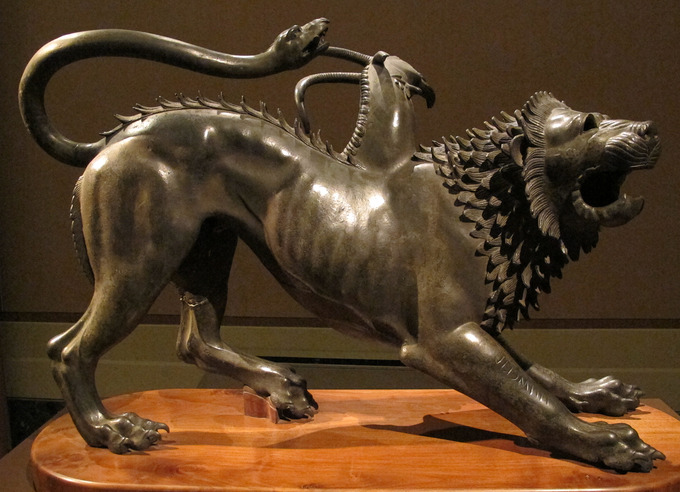
The bronze statue demonstrates Etruscan artistic techniques and how the liveliness seen in Etruscan terra cotta sculpture is transmitted into the bronze medium . The figure is well modeled and expressive—from its tense muscles, ready pose, and roaring face of the lion and goat. The beast’s ribs are clearly visible and a wound on its rump bleeds. The lion’s posture—he crouches and looks up—suggests that there may have been an additional figure of Bellerophon to create a votive group. The figure’s face and mane is stylized and the patterning is reminiscent of Near Eastern depictions of lions.
Ombra della sera
Produced in the metal-rich town of Velathri (later Volterra), the Ombra della sera (Italian for Evening Shadow) represents a male nude that is nearly two feet high. Archaeologists estimate its date of production to the third century BCE.
In ancient times, Volterra bronze workers were known for their ability to fuse copper ores with tin to form bronze. The body of the sculpture is very elongated, while the scale of its head is naturalistic.
The title Ombra della sera was applied to the sculpture centuries later by a poet who likened its exaggerated form to shadows cast by the setting sun. These unusual proportions lead some experts to believe that the sculpture was intended as a votive offering.
Mars of Todi
The so-called Mars of Todi (late fifth-early fourth century BCE) is a nearly life-size bronze warrior produced as a votive offering, possibly to Laran, the Etrucscan god of war. The figure probably held a patera (libation bowl) in his extended right hand, and a spear in the left.
His helmet is missing, but his body armor is one of the best surviving examples that shows how plate armor from the period appeared. Unlike the Ombra della sera, the Mars of Todi is very naturalistic, complete with a dynamic contrapposto pose and inlaid eyes.
A dedication that combines the Etruscan alphabet and Latin dialect from Umbria (central Italy) is inscribed on the skirt of the breastplate. It translates as, “Ahal Trutitis gave [this as a] gift.” Interestingly, the name of the donor was Celtic in origin, denoting the cosmopolitan nature of the region in ancient times.
Bronze Objects
The Etruscans also used bronze to create small objects, including storage jars, or cistae, and mirrors. Etruscan bronze mirrors were used by women and often deposited as grave goods. These mirrors were highly burnished on one side to reflect an image, and on the other side were decorated with engraved or low-relief casted scenes.
The images depicted were often scenes from Greek mythology, that demonstrate the importation of Greek culture and mythology. Many of these mirrors were inscribed with the deceased’s name, and ritual blessings.

Cistae were also often inscribed and were also decorated with engravings and added bronze elements, such as feet, chains, and decorative handle lids. The cistae were small boxes with lids, much like a pyxis , that was made from bronze and was usually cylindrical.
The handles of the lids were often figures, such as a man or a sphinx , or figural groups. Like the mirrors, the engraved scenes represented images from mythology, but some images also depict scenes from Etruscan history.
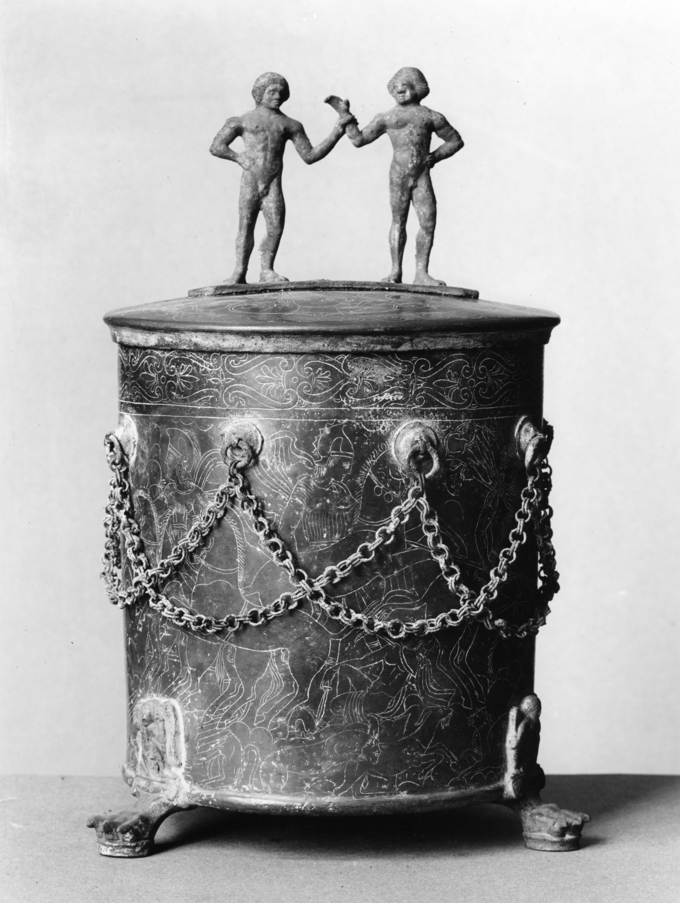
Etruscan Art under the Influence of the Romans
As the Etruscan territories fell under Roman dominance, Etruscan culture and art changed to reflect Roman influence and new cultural values.
Describe the changes that appeared in Etruscan art during the Roman period
Key Points
- Funerary imagery changed in Etruscan society as the Etruscans began to encounter violence and conquest by their Roman neighbors. The figures of the underworld demons Charun and Vanth, as well as apotropaic figures, are depicted in tomb paintings and and on sarcophagi during the Etrusco-Roman period.
- The Sarcophagus of Lars Pulena not only depicts the figures of Charun and Vanth, the lid also depicts the deceased as a prosperous and wealthy Etruscan, complete with a scroll listing his accomplishments. The sarcophagus demonstrates the shifting values in Etruscan society.
- The life-size bronze statue of Aule Metele depicts an Etruscan man dressed and behaving as a Roman. The man wears a toga and Roman sandals and is posed in a position of oration, as would be common for a Roman magistrate. The sculpture demonstrates the mixing of Etruscan and Roman styles and culture .
- Temple sculpture also changed during the Roman period, with terra cotta pedimental sculptures adorning at least two temples during the second century BCE. Both sculpture groups display Graeco-Roman naturalism in the depiction of the body. One group wears Roman-style military attire.
Key Terms
- veristic: Realistic; true to life.
- cinerary urn: A vessel used to hold the ash remains of the cremated deceased.
Etruscan Art under Rome
In 509 BCE, the Etruscan kings of Rome were expelled from the city, and the Roman Republic was established. By the fourth century BCE, Rome was beginning to expand across the Italian peninsula, and the first Etruscan city to fall was Veii in 396 BCE.
Over the following centuries, Etruria was involved in Roman wars, and Etruscan territory was fully conquered by the Romans by the beginning of the first century BCE. While Roman culture drew from its Etruscan roots, borrowing and adapting Etruscan customs, Etruscan society was also influenced by Roman culture.
During this period, art begin to adopt a Roman style and display the permeation of Roman culture and values into Etruscan society. The threat of invasion also led to the common presence of violence, especially in funerary images.
Funerary Art and Sarcophagi
Funerary art , both in tomb paintings and on carved sarcophagi, underwent a noticeable change in subject matter during the Roman period. The figures of Charun and Vanth, demons of the underworld, were depicted with increasing regularity.
Both figures are often depicted with wings, while Charun is often depicted with blue skin to signify putrefying flesh. They also carry torches, used to light the way to the underworld, or sometimes keys to open the door to the underworld, which underline the figures’ role as guides between the world of the living and the world of the dead. In the tomb paintings in Tarquinia, the figures of Charun and Vanth can be seen painted in front of or around doorways.
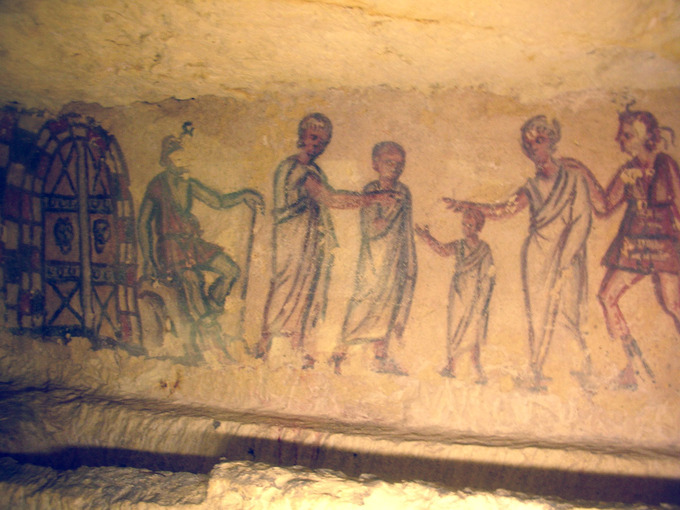
While Charun’s name is likely a derivative of the Greek underworld ferryman Charon, Vanth appears to be uniquely Etruscan. Due to Charun’s menacing associations, theories have attempted to associate Vanth with the avenging Greek Furies. However, her role as a benevolent guide conflicts with this suggestion.
Regardless of Vanth’s exact role and origins, the appearance of a less-than-joyous afterlife and menacing figures in Etruscan funerary art does not emerge until after the beginning of the Roman incursions into Etruscan territory. Perhaps Vanth is a gentler apotropaic figure, offering the reassurance of an ally in the afterlife to counteract the trials faced in the face of impending cultural collapse and absorption.
The Sarcophagus of Lars Pulena
Charun and Vanth also appear on stone and terra cotta sarcophagi. Charun is also sometimes depicted with a hammer. On the Sarcophagus of Lars Pulena, two figures of Charun (with hammers but without wings) are depicted on either side of a central figure, most likely Lars Pulena, swinging their hammers at his head. The violent image might have been used as an apotropaic device to ward off evil.
However, in comparison to earlier funerary images, the level of violence seems to mimic the new level of violence in Etruscan society from Roman forces and influence. Two winged representations of Vanth also appear on the sarcophagus, at either end of the frieze .
The lid of the sarcophagus depicts a portrait of the deceased. The man lies alone, wearing a somber expression, unlike the earlier terra cotta Sacophagus of the Spouses.
His face is wrinkled and reflects a Roman republican portrait style, which equates age with wisdom and leadership capabilities. He has a pot belly, signifying his wealth, good life, and robust eating, and he holds a scroll across his lap that is inscribed with a list of his accomplishments.
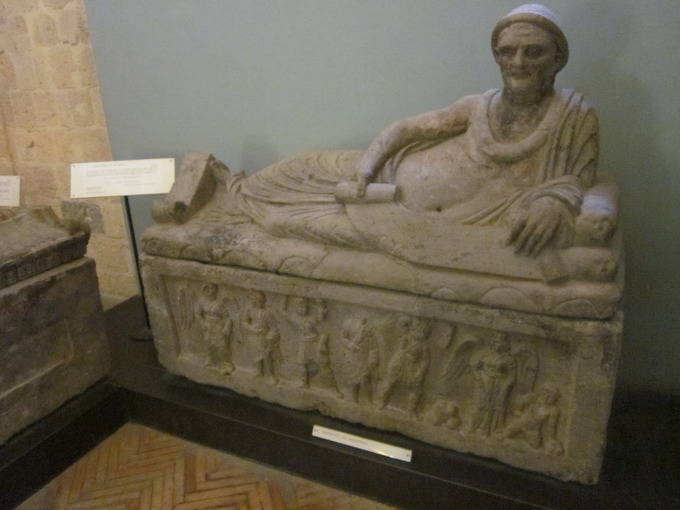
Smaller cinerary urns assumed the shapes of sarcophagi during this period. These urns are topped with images of the deceased lying across the lid, often in Roman dress, with relief-carved scenes of battle, violence, or Charun and Vanth.
The woman who reclines atop the urn wears attire more akin to that of a Roman matron than to the woman on the Sarcophagus of the Spouses. Unlike the Etruscans, who buried their dead in tombs designed to mimic the appearance and comforts of private homes, the Romans practiced cremation and stored the ashes of their deceased in cinerary urns. This shift in Etruscan culture demonstrates the adoption of Roman funerary practices.
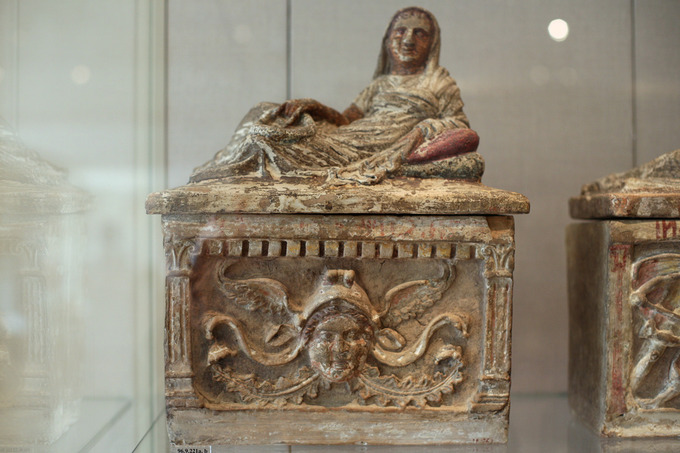
Aule Metele
Aule Metele, also known as The Orator, is a life-size bronze sculpture of an Etrusco-Roman man. The figure is depicted wearing a Roman toga and Roman sandals. He stands in a pose of an orator, with his hand raised to address a crowd. To further emphasize this gesture, the hand is slightly enlarged.
He is clearly depicted as an individual, and an inscription on the hem of his toga in Etruscan names him as Aule Metele. Aule Metele dresses as a Roman magistrate, and his face is a cross between Hellenistic and Roman veristic portraiture.

The sculpture shows a level of individuality through the gaunt cheeks, thin lips, and wrinkled forehead. As with the sculpture on the Sarcophagus of Lars Pulena, these attributes of age align with the respect afforded to elders in Roman society. While the inscription marks him as an Etruscan, his attire and pose demonstrate the absorption of Roman culture into Etruscan society and the adoption—especially by the ruling class of Etruscans—of Roman civic practices.
Late Temple Sculpture
By the second century BCE, at least two Etruscan temples began to show evidence of the absorption of the Roman culture. Unlike early temples, whose pediments were largely unadorned, the temples in the cities of Luna and Talamone incorporated pedimental sculptures in the style of the Greeks.
Although Roman pediments remained free of sculpture groups, the Roman influence is clearly visible in these terra cotta figures. Whereas pre-Roman temple sculptures were largely stylized like the Apulu of Veii, the pedimental figures from the temples at Luna and Talamone possess the naturalism of Classical and Hellenistic sculpture, both of which were adopted by the Romans.
Unlike Greek pedimental sculpture that depicted male nudes, the figures from the pediment from Talamone, which depicts the fate of the Seven against Thebes, wear Roman battle gear, including short-sleeved skirted armor. By the time the sculpture groups from both temples were produced, their cities were under Roman control.
- Curation and Revision. Provided by: Boundless.com. License: CC BY-SA: Attribution-ShareAlike
- 360px-Museo_guarnacci,_ombra_della_sera_01.jpeg. Provided by: Wikimedia Commons. Located at: commons.wikimedia.org/w/index.php?curid=5320392%20. License: CC BY: Attribution
- Etruscan - Cista with Cover Depicting the Conflict of the Gauls and Etruscans - Walters 54133. Provided by: Wikimedia. Located at: commons.wikimedia.org/wiki/File:Etruscan_-_Cista_with_Cover_Depicting_the_Conflict_of_the_Gauls_and_Etruscans_-_Walters_54133.jpg. License: CC BY-SA: Attribution-ShareAlike
- Mirror Judgement of Paris Louvre Bj1734. Provided by: Wikimedia. Located at: commons.wikimedia.org/wiki/File:Mirror_Judgement_of_Paris_Louvre_Bj1734.jpg. License: CC BY-SA: Attribution-ShareAlike
- Chimera d'arezzo, fi, 04. Provided by: Wikipedia. Located at: en.Wikipedia.org/wiki/File:Chimera_d'arezzo,_fi,_04.JPG. License: CC BY-SA: Attribution-ShareAlike
- 320px-0_Mars_de_Todi_-_Museo_Gregoriano_Etruscano_(1).jpeg. Provided by: Wikimedia Commons. Located at: commons.wikimedia.org/w/index.php?curid=18381501. License: CC BY-SA: Attribution-ShareAlike
- Etruscan History. Provided by: Wikipedia. Located at: en.Wikipedia.org/wiki/Etruscan_history. License: CC BY-SA: Attribution-ShareAlike
- Etruscan Language. Provided by: Wikipedia. Located at: en.Wikipedia.org/wiki/Etruscan_language%23Specula. License: CC BY-SA: Attribution-ShareAlike
- Mars of Todi. Provided by: Wikipedia. Located at: en.Wikipedia.org/wiki/Mars_of_Todi. License: CC BY-SA: Attribution-ShareAlike
- Lost-Wax Casting. Provided by: Wikipedia. Located at: en.Wikipedia.org/wiki/Lost-wax_casting. License: CC BY-SA: Attribution-ShareAlike
- Ombra della Sera. Provided by: Wikipedia. Located at: fr.Wikipedia.org/wiki/Ombra_della_sera. License: CC BY-SA: Attribution-ShareAlike
- Ombra della Sera. Provided by: Enhanced Wiki. Located at: http://enhancedwiki.altervista.org/?title=Ombra_della_sera. License: CC BY-SA: Attribution-ShareAlike
- Bronze Mirror. Provided by: Wikipedia. Located at: en.Wikipedia.org/wiki/Bronze_mirror. License: CC BY-SA: Attribution-ShareAlike
- Etruscan Art. Provided by: Wikipedia. Located at: en.Wikipedia.org/wiki/Etruscan_art. License: CC BY-SA: Attribution-ShareAlike
- Chimera of Arezzo. Provided by: Wikipedia. Located at: en.Wikipedia.org/wiki/Chimera_of_Arezzo. License: CC BY-SA: Attribution-ShareAlike
- Cista. Provided by: Wikipedia. Located at: en.Wikipedia.org/wiki/cista. License: CC BY-SA: Attribution-ShareAlike
- Pyxis. Provided by: Wiktionary. Located at: en.wiktionary.org/wiki/pyxis. License: CC BY-SA: Attribution-ShareAlike
- Engrave. Provided by: Wiktionary. Located at: en.wiktionary.org/wiki/engrave. License: CC BY-SA: Attribution-ShareAlike
- 640px-Museo_archeologico_di_Firenze,_frontone_di_Talamone_1.jpeg. Provided by: Wikimedia Commons. Located at: commons.wikimedia.org/w/index.php?curid=1464441. License: CC BY-SA: Attribution-ShareAlike
- MMA etruscan urn 01. Provided by: Wikimedia. Located at: commons.wikimedia.org/wiki/File:MMA_etruscan_urn_01.jpg. License: CC BY-SA: Attribution-ShareAlike
- 632px-Frontone_A_del_grande_tempio_di_luni_con_concilio_degli_dei,_175-150_ac._ca._01.jpeg. Provided by: Wikimedia Commons. Located at: commons.wikimedia.org/w/index.php?curid=40178069. License: CC BY-SA: Attribution-ShareAlike
- Sarcophagus of the magistrate. Provided by: Wikimedia. Located at: commons.wikimedia.org/wiki/File:Sarcophagus_of_the_magistrate.jpg. License: CC BY-SA: Attribution-ShareAlike
- Boundless. Provided by: Amazon Web Services. Located at: s3.amazonaws.com/figures.boundless.com/50a94216e4b0e5a61a9275c5/tarqunia---charun-and-vanth.jpg. License: CC BY-SA: Attribution-ShareAlike
- L'Arringatore. Provided by: Wikipedia. Located at: en.Wikipedia.org/wiki/File:L'Arringatore.jpg. License: CC BY-SA: Attribution-ShareAlike
- Talamone. Provided by: Wikipedia. Located at: en.Wikipedia.org/wiki/Talamone. License: CC BY-SA: Attribution-ShareAlike
- Luna (Etruria). Provided by: Wikipedia. Located at: en.Wikipedia.org/wiki/Luna_(Etruria). License: CC BY-SA: Attribution-ShareAlike
- Roman Sculpture. Provided by: Wikipedia. Located at: en.Wikipedia.org/wiki/Roman_sculpture. License: CC BY-SA: Attribution-ShareAlike
- Roman Funerary Practices. Provided by: Wikipedia. Located at: en.Wikipedia.org/wiki/Roman_funerary_practices#Disposal_of_the_body. License: CC BY-SA: Attribution-ShareAlike
- Etruscan Architecture. Provided by: Wikipedia. Located at: en.Wikipedia.org/wiki/Etruscan_architecture. License: CC BY-SA: Attribution-ShareAlike
- Ancient Roman sarcophagi. Provided by: Wikipedia. Located at: en.Wikipedia.org/wiki/Ancient_Roman_sarcophagi. License: CC BY-SA: Attribution-ShareAlike
- The Orator. Provided by: Wikipedia. Located at: en.Wikipedia.org/wiki/The_Orator. License: CC BY-SA: Attribution-ShareAlike
- Clothing in Ancient Rome. Provided by: Wikipedia. Located at: en.Wikipedia.org/wiki/Clothing_in_ancient_Rome#Women.27s_clothing. License: CC BY-SA: Attribution-ShareAlike
- Charun. Provided by: Wikipedia. Located at: en.Wikipedia.org/wiki/Charun. License: CC BY-SA: Attribution-ShareAlike
- Vanth. Provided by: Wikipedia. Located at: en.Wikipedia.org/wiki/Vanth. License: CC BY-SA: Attribution-ShareAlike
- Etruscan Art. Provided by: Wikipedia. Located at: en.Wikipedia.org/wiki/Etruscan_art. License: CC BY-SA: Attribution-ShareAlike
- Aule Metele. Provided by: Wikipedia. Located at: en.Wikipedia.org/wiki/Aule_Metele. License: CC BY-SA: Attribution-ShareAlike
- Arringatore. Provided by: Wikipedia. Located at: it.Wikipedia.org/wiki/Arringatore. License: CC BY-SA: Attribution-ShareAlike
- Etruscan History. Provided by: Wikipedia. Located at: en.Wikipedia.org/wiki/Etruscan_history. License: CC BY-SA: Attribution-ShareAlike
- Sarcophagi Personalization. Provided by: Wikipedia. Located at: en.Wikipedia.org/wiki/Sarcophagi_personalization%23Sarcophagus_Of_Lars_Pulena. License: CC BY-SA: Attribution-ShareAlike
- Cinerary Urn. Provided by: Wikipedia. Located at: en.Wikipedia.org/wiki/cinerary%20urn. License: CC BY-SA: Attribution-ShareAlike
- Definition of Veristic in Art History. Provided by: Boundless Learning. Located at: www.boundless.com/art-history/definition/veristic. License: CC BY-SA: Attribution-ShareAlike


